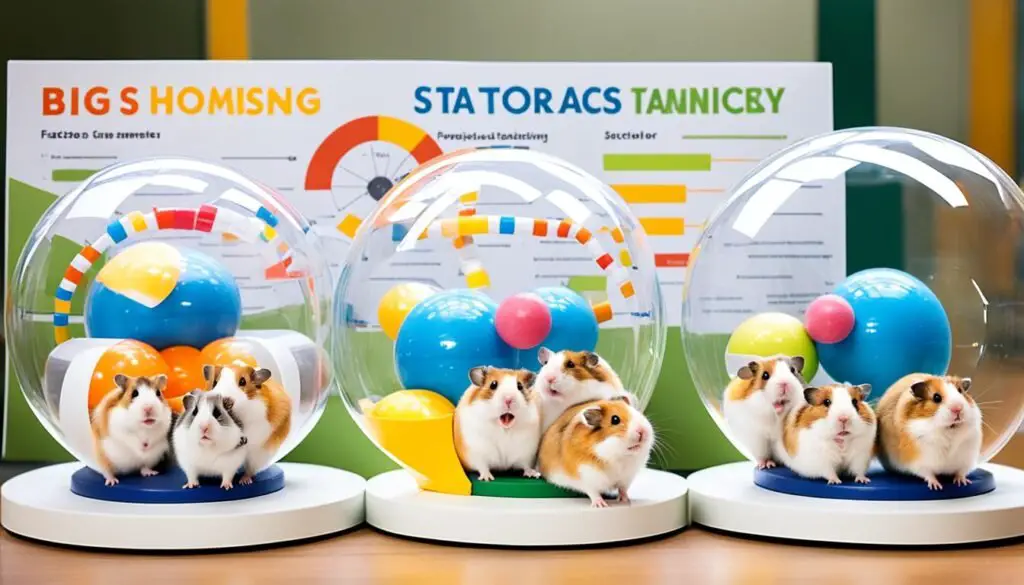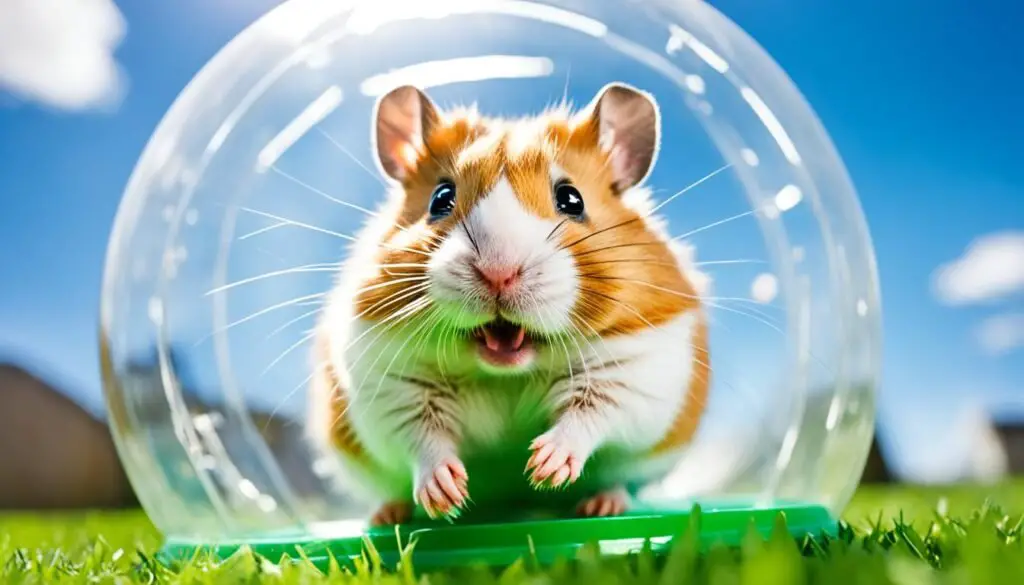Did you know that the size of a hamster’s balls can reach up to 1/4 of their body size? It’s true! These adorable little creatures have a natural phenomenon that results in noticeably large testicles. While this may seem surprising, it’s usually not a cause for concern in most cases.
Understanding the reasons behind big hamster balls is essential for ensuring the health and well-being of your furry friend. In this article, we will delve into the intricate world of hamster anatomy, providing insights into their reproductive system, factors affecting testicle size, when to be concerned, and tips for proper care. So, let’s explore this fascinating topic and learn more about your hamster’s health and happiness!
The Natural Growth of Hamster Testicles
Hamsters reach sexual maturity within the first 3 months of their life, and during this time, their testicles continue to grow. This rapid growth is a natural part of the hamster’s reproductive system, as they need to produce a significant amount of sperm for reproduction. The size of their testicles may vary depending on the breed, with larger hamsters, such as Syrian hamsters, generally having bigger testicles. It is important to note that testicle growth should stop by the time the hamster reaches adulthood, typically around 3 months of age.
Factors Affecting Testicle Size
Several factors can influence the size of a hamster’s testicles. One such factor is the hormonal changes that occur when the hamster reaches sexual maturity. During this time, the testicles may become more visible as the hamster demonstrates mating behavior. This is a natural part of their hamster behavior.
Additionally, changes in weather can also impact the size of the testicles. In warmer weather, the testicles may appear larger as the hamster tries to regulate its body temperature. On the other hand, in colder weather, the testicles may appear smaller as they contract to retain heat. It’s fascinating to observe how the hamster body structure responds to changes in its environment.

When to Be Concerned About Big Hamster Balls
While big hamster balls are generally not a cause for concern, there are certain situations where it may indicate underlying health issues. If the testicles continue to grow after the hamster has reached adulthood or if there is redness, swelling, or a lump on the testicles, it is advisable to consult a veterinarian. Swelling and tumors can occur in hamsters’ testicles and may require medical attention. Regular monitoring of the testicles and seeking veterinary care when necessary is essential for the well-being of the hamster.
Conducting a Temperature Test
If you suspect that your hamster’s testicles may be swollen or that there may be a tumor present, you can perform a temperature test. This involves placing the hamster in a cold room and observing if the testicles expand or remain swollen. If the testicles do not expand significantly, it may indicate swelling or the presence of a tumor. In such cases, it is crucial to seek veterinary care as soon as possible to determine the cause and provide appropriate treatment.
One way to check for testicle swelling or tumors in your hamster is by conducting a temperature test. Use a cold room or place an ice pack near your hamster’s cage. Observe if the testicles shrink or remain enlarged. If they do not reduce in size, this could be a sign of swelling or a tumor. Seeking veterinary care promptly is important to diagnose the underlying issue and ensure your hamster’s health.
Make sure to handle your hamster gently and slowly during the temperature test. Stress can affect their testicle size, so creating a calm and relaxing environment is essential. If you notice any abnormal testicle swelling, it’s important to consult a veterinarian for a proper diagnosis and treatment plan.
Performing a temperature test can help determine if your hamster’s testicle swelling is due to a tumor or other health issues.
Taking Care of Your Hamster’s Testicles
As a hamster owner, it’s important to prioritize the care and wellbeing of your furry friend’s testicles. By taking a few simple steps, you can help ensure their health and happiness.
Firstly, provide your hamster with a cage that has rounded edges. Sharp edges can pose a risk of injury to the bottom of the hamster, including the delicate testicle area. By choosing a cage with smooth, rounded edges, you can minimize the risk of accidents and keep your hamster safe.
Secondly, consider the size of your hamster wheel. Opting for a large-sized hamster wheel will help prevent any injuries to the testicles during exercise. A wheel that is too small may put unnecessary strain on the reproductive area, potentially causing discomfort or injury. So, choose a wheel that is suitable for your hamster’s size and breed.
Regularly monitoring your hamster’s testicles is also crucial. Take the time to inspect them for any changes or abnormalities, such as redness, swelling, or lumps. Any unusual findings should be promptly reported to a veterinarian. By staying vigilant and seeking professional care when necessary, you can address any potential health issues early on, ensuring the overall wellbeing of your hamster.
Remember, hamster care extends beyond just providing food and water. Taking care of your hamster’s testicles is an important aspect of their overall health. By following these tips and providing the necessary care, you can create a safe and comfortable environment for your furry friend.
Common Concerns and FAQs
As a new hamster owner, it’s natural to have concerns about your furry friend’s testicles. Here, we address some common questions to help you better understand hamster health, care, and breeding.
Can hamsters be castrated?
No, hamsters cannot be castrated. Unlike other pets like dogs and cats, castration surgery is not commonly performed on hamsters. If you’re concerned about breeding or aggression, it’s best to keep male and female hamsters separate.
Why are testicles more visible in some hamster breeds?
Testicles may be more visible in certain hamster breeds such as Syrian hamsters due to their larger size. The increased visibility is a characteristic of the breed and is not a cause for concern. However, if you notice any abnormalities or changes in size, it’s advisable to consult a veterinarian.
What is the significance of testicle size?
The size of a hamster’s testicles is primarily related to the animal’s reproductive system and breeding capabilities. It’s important to note that variations in size are normal within a healthy range. If you have specific concerns about testicle size, it’s best to consult a veterinarian for a professional assessment.
By addressing these common concerns, hamster owners can develop a better understanding of their pets’ anatomy, behavior, and overall well-being. Remember to always observe your hamster’s health closely and seek professional advice if you notice any unusual changes.

Conclusion and Final Thoughts
In conclusion, big hamster balls are a natural part of a hamster’s anatomy and reproductive system. While they may appear significant in size, they are usually not a cause for concern. However, it is important for hamster owners to stay vigilant and monitor their pet’s testicles for any changes or abnormalities.
Regular veterinary check-ups are essential for ensuring the overall health and well-being of your hamster. During these visits, a veterinarian can assess the testicles and address any concerns you may have. If you notice redness, swelling, or lumps on the testicles, it is crucial to seek prompt medical attention.
By understanding the reasons behind big hamster balls and taking appropriate care, you can provide a happy and healthy life for your furry companion. Remember to provide a cage with rounded edges to prevent injuries, use a large-sized hamster wheel to minimize the risk of trauma during exercise, and monitor the testicles regularly for any changes.
With proper hamster care and regular veterinary support, you can ensure the well-being of your pet and enjoy the companionship of your hamster for years to come.
